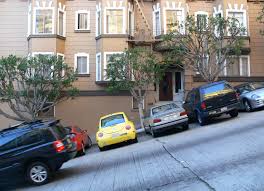Guest Editorial: Eisenhower’s Parking Policies No Longer Work for San Francisco
12:09 PM PDT on August 19, 2016

The last time San Francisco looked comprehensively at how we plan for parking, Eisenhower was president, gas was 25 cents a gallon, and we hadn’t even started building BART. It was an era when cities came to be dominated by drive-ins and drive-thrus, when streetcar lines were were being torn up, and new freeways were bulldozing old neighborhoods. As a result, our city’s parking policy still acts as a viagra for traffic, pollution and unaffordability.
As the City debates a Transportation Demand Management ordinance aimed at taming traffic congestion, now is the time to update San Francisco's parking requirements, from the ground up. The City has decided it’s time to tackle congestion, and commissioned a survey of research on what works. The research concluded that “available parking is perhaps the single biggest factor in people’s decision to drive. The research shows that just building housing on a transit line doesn’t reduce automobile use, but reducing parking does.” We’re also in the city’s worst-ever housing affordability crisis, and parking requirements are a key culprit in driving up housing costs. Refreshing San Francisco’s parking policy critical to growing an affordable, sustainable city with vital and dynamic neighborhoods.
San Francisco should stop forcing parking on homes and businesses that do not need or want it. Paying for superfluous parking drives up housing and business costs, and worsens the city’s housing shortage and our escalating commercial rents.
Removing the 1950s era parking mandates would also free up space for more housing. Families should be allowed to convert their unused garages into the bedroom of an elderly parent, or convert them to in-law units so that they can earn rent money to help pay a mortgage or provide retirement income.
On commercial and transit corridors we should allow driveways and the ground floors of parking garages to be converted into small shops for neighborhood merchants. New storefront spaces provide less expensive alternatives in neighborhoods where retail rents are skyrocketing, and will help restore dynamism and much needed foot-traffic to local streets. In addition, private driveways eliminate valuable on-street public parking that can be used by patrons of local businesses.
Forcing extra parking upon those who do not want it or need it is not just a burden in terms of cost and space, it also acts as a big inducement for driving. Recent research out of UC Berkeley shows that imposed parking mandates significantly increase the proportion of people who drive alone in their cars, even in communities adjacent to high quality transit like BART. Incentives to drive alone are also incentives for congestion, air pollution and greenhouse gas emissions - all scourges that we want our city to be fighting against not encouraging.
We have made incremental steps in removing parking mandates in a few neighborhoods - starting in the 1980s with the Downtown Plan, and continuing into portions of the Eastern Neighborhoods and in small portions of the rest of the city through the Better Neighborhoods plans of the 1990s and 2000s. This new approach to parking has helped keep neighborhood commercial streets vital, decreased the cost of new housing, and reduced runaway congestion. But this piecemeal approach to parking mandates has taken us as far as it can, and it’s now time to rewrite the rules at the city-level so the whole city can benefit from up to date parking policy.
Eliminating parking mandates doesn’t mean that parking will altogether disappear. San Francisco currently has over 450,000 parking spots - if you lined them up end to end they would stretch from Mexico past the Oregon border - and the vast majority of them are going nowhere. It doesn’t mean that all new developments won’t have parking; instead, builders and homeowners need only add the parking that building users really need, rather than fulfill an arbitrary mandate.
While San Francisco likes to set the national trend, on parking policy we would merely be playing catch-up. In recent years, cities across the country -- Oakland, Sacramento, Miami, Philadelphia, Buffalo, and others -- have reduced or eliminated parking mandates citywide, and are improving how on-street parking is managed.
To deliver 21st century mobility and retain a vibrant, affordable and sustainable city, now is the time rewrite Eisenhower’s parking rules for today’s and tomorrow’s San Francisco.
Tom Radulovich is President of the BART Board, representing District 7, and Executive Director of Livable City
Nick Josefowitz is also a BART Board member, representing District 8, and founder of Leadership for a Clean Economy
A version of this editorial appeared in the San Francisco Examiner
Stay in touch
Sign up for our free newsletter
More from Streetsblog San Francisco
Commentary: There is Zero Ambiguity to the West Portal Tragedy
What happened in West Portal was entirely predictable and preventable. The city must now close Ulloa to through traffic and make sure it can never happen again




